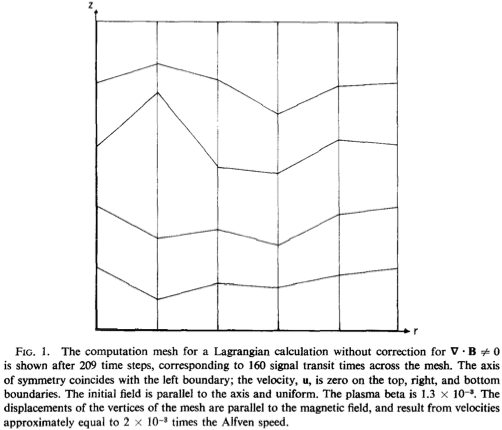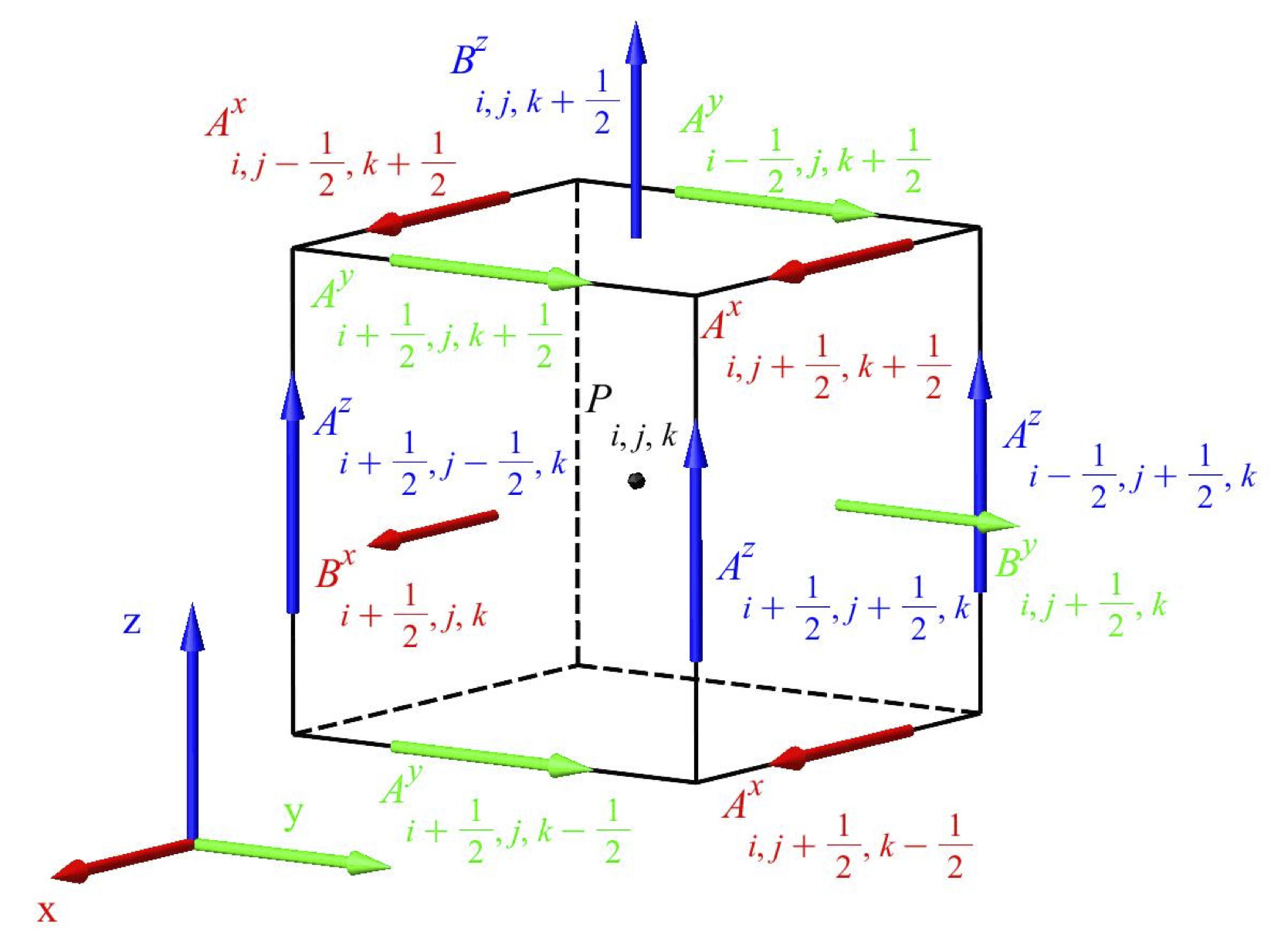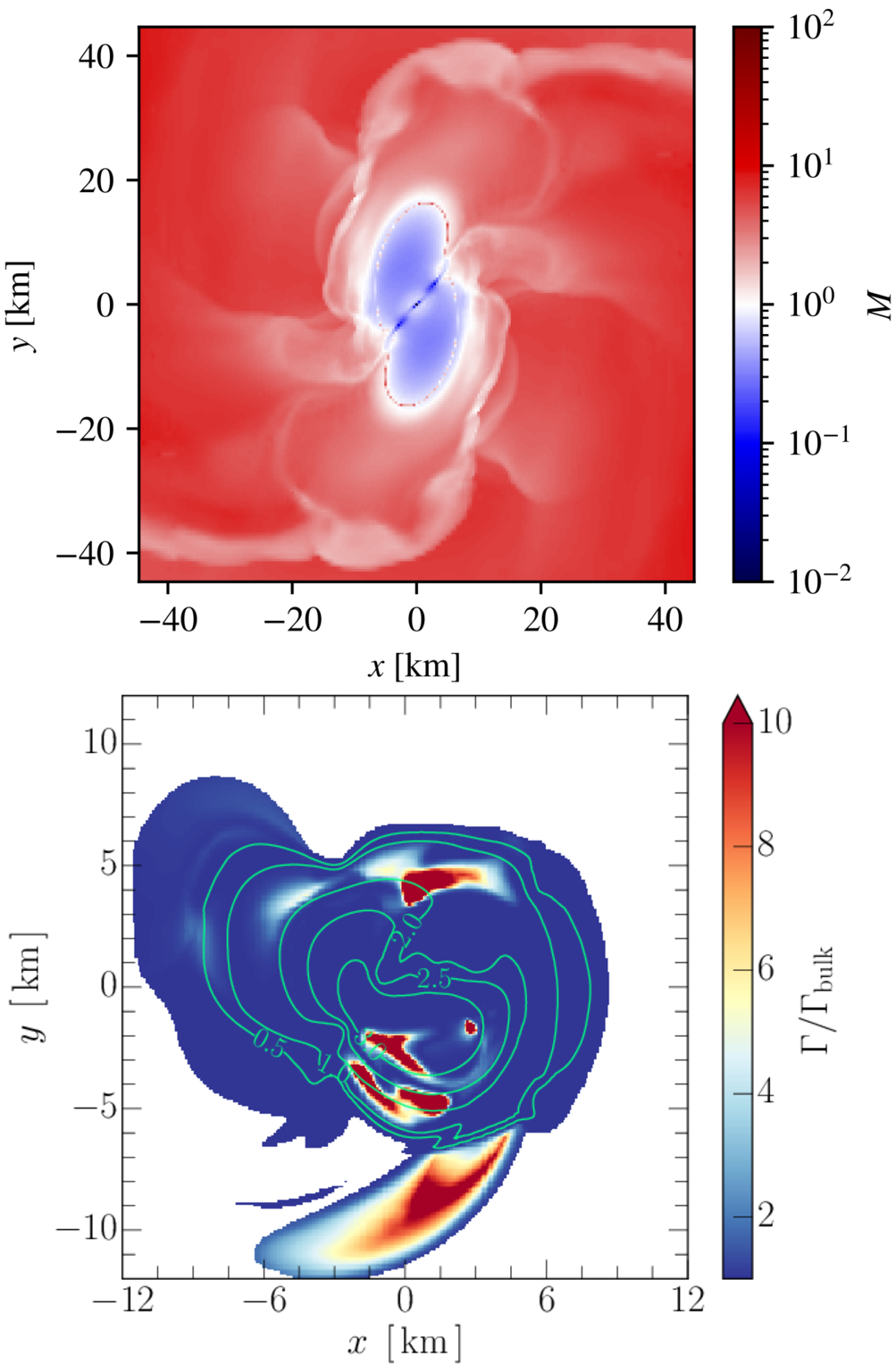Numerical Methods for Matter in GR
- Ian Hawke
- github.com/IanHawke
- orcid.org/0000-0003-4805-0309
- STAG, University of Southampton
What matters
$$ G_{ab} = 8 \pi T_{ab}, \quad \textrm{where } T_{ab} = \dots $$- scalar fields;
- simple fluids (dust, barotropes);
- finite $T$, real $Y_\text{x}$ fluids;
- electromagnetism (MHD, resistivity, ...);
- neutrinos, ...
ETK:
- couple $T_{ab} \leftrightarrow G_{ab}$;
- provides solvers for perfect MHD, constituitive interfaces;
- builds on spacetime infrastructure.
Conservation
EFEs imply $\nabla_a T^{ab} = 0$.
Pick a tetrad, $e_b^{(j)}$ to get $$ \begin{aligned} && \nabla_a \left[ e_b^{(j)} T^{ab} \right] &= \tfrac{1}{\sqrt{-g}} \partial_a \left( \sqrt{-g} e_b^{(j)} T^{ab} \right) = -T^{ab} \nabla_a e_b^{(j)} \\ \implies && \partial_t {\bf q} + \partial_i {\bf f}^{(i)}({\bf q}) &= {\bf s}. \end{aligned} $$ Balance law form.
Only four equations: need other constituitive equations for, eg, EM, particle number, etc.
Relations may need variables other than ${\bf q}$: conservative to primitive problem.
Shock formation
Advection equation $$ \partial_t q + \partial_x (v q) = 0. $$ Information moves right, speed $v$.
Burgers equation $$ \partial_t q + \tfrac{1}{2} \partial_x q^{2} = 0. $$ Information moves right, speed $q$.
Shocks form.
Nonlinearity
Formally need to work with weak form
$$ \begin{aligned} && \partial_t q + \nabla_k f^{(k)}(q) & = 0 \\ \implies && \frac{\text{d}}{\text{d}t} \int_V q + \oint_{\partial V} \hat{n}_k f^{(k)}(q) & = 0. \end{aligned} $$Discrete version, 1d:
$$ \frac{\text{d}}{\text{d}t} \hat{q}_i + \frac{1}{\Delta x} \left[ f_{i+1/2} - f_{i-1/2} \right] = 0. $$
Finding the flux $f_{k \pm 1/2}$ depends on the model (for fluids see GRHydro etc).
Consistency
Using the right weak form is essential.
$$ \begin{aligned} && \partial_t q^n + \frac{n}{n+1} \partial_x q^{n+1} & = 0 \\ \implies && \partial_t q + q \partial_x q & = 0. \end{aligned} $$Strong solutions agree when continuous; inconsistent at shocks.
Can use entropy pairs, path-consistent methods for complex cases.
Algorithm outline
Discrete version, 1d:
$$ \frac{\text{d}}{\text{d}t} \hat{q}_i + \frac{1}{\Delta x} \left[ f_{i+1/2} - f_{i-1/2} \right] = 0. $$- Reconstruct $\{ \hat{q}_i \} \to q(x)$;
- Solve discontinuous problem at cell boundaries.
- Sources "just" add (stiffness?);
- Can reconstruct $f$ directly;
-
Use
MoLin time; - High accuracy needs good reconstruction and time evolution.
Reconstruction
Any high order method shows Gibbs' oscillations at jumps.
No convergence with resolution.
Use piecewise polynomial reconstruction (eg WENO) to avoid oscillations.
- Converges with resolution.
- Formally first order at jumps.
- Much more expensive than linear FD.
- Extension to higher dimensions an issue.
- Total variation $\sup_i \sum | {\bf q}_{i+1} - {\bf q}_i |$ bounded.
See GRHydro, IllinoisGRMHD, Spritz, WhiskyTHC.
Riemann Solvers
- Reconstruction $\to$ Riemann Problem;
- Full solution as waves: expensive;
- Approximations usually enough;
- Roe - linearize:
- sharp;
- entropy violations.
- Marquina - fixes Roe:
- flux formula only;
- expensive.
- HLL(E) - impose number of waves:
- cheap;
- positive;
- diffusive.
Entropy functions
Entropy $\eta({\bf q})$ is convex function, flux $\psi$, s.t.
$$ \partial_t \eta + \partial_x \psi \le 0, \quad \nabla_{\bf q} \psi = \nabla_{\bf q} \eta \nabla_{\bf q} {\bf f}. $$Entropy picks out unique weak solution.
Given two solutions ${\bf q}_{1, 2}$, then
$$ \frac{d}{dt} \| {\bf q}_{1} - {\bf q}_{2} \| \le 0 $$only if both are entropy solutions.
Conclusion: if numerical scheme violates entropy condition, it can and will diverge from true solution.
MHD
- Still conservation laws (ideal case).
- Constraint $\mathcal{C} = \nabla \cdot {\bf B} \equiv 0$ essential.
- Can either
- add damping terms $\propto - \mathcal{C}$
- enforce $\mathcal{C}=0$ discretely.
- Using vector potential does the latter - preferred.
- Entropy function evolution has term $\propto \mathcal{C}$


Summary
ETK matter simulations
- focus on finite volume approaches;
- are "good enough" (?) for LIGO, but...
- are costly, inaccurate (compared to spacetime).
Focus on shocks important, but restricts accuracy.
Long term accuracy needs better approaches (DG, compact FD will help).
Fast/short effects need LES-type treatment.
Entropy stability only non-negotiable.

Further reading
- Marti & Müller, Grid-based Methods in Relativistic Hydrodynamics and Magnetohydrodynamics, Living Review. SR only but updated in 2015. See also the original version from 2003.
- Balsara, Higher-order accurate space-time schemes for computational astrophysics—Part I: finite volume methods, Living Review. Very methods heavy. Cutting edge but not easy going.
- Leveque, Finite Volume Methods for Hyperbolic Problems, CUP. No astrophysics but one of the standard numerical methods texts.
- Hesthaven, Numerical Methods for Conservation Laws: From Analysis to Algorithms, SIAM. Still no astrophysics and even more mathematical-technical, but goes deep into methods like Discontinuous Galerkin.
- Open Astrophysics Bookshelf. Relativity isn't a focus but the material covers a lot of numerics in great depth, with example codes throughout. Have a look at github.com/python-hydro for detailed examples in one and two dimensions.
- Uncertainty Quantification. A review of a crucial, but very difficult, task for the next generation of simulations.